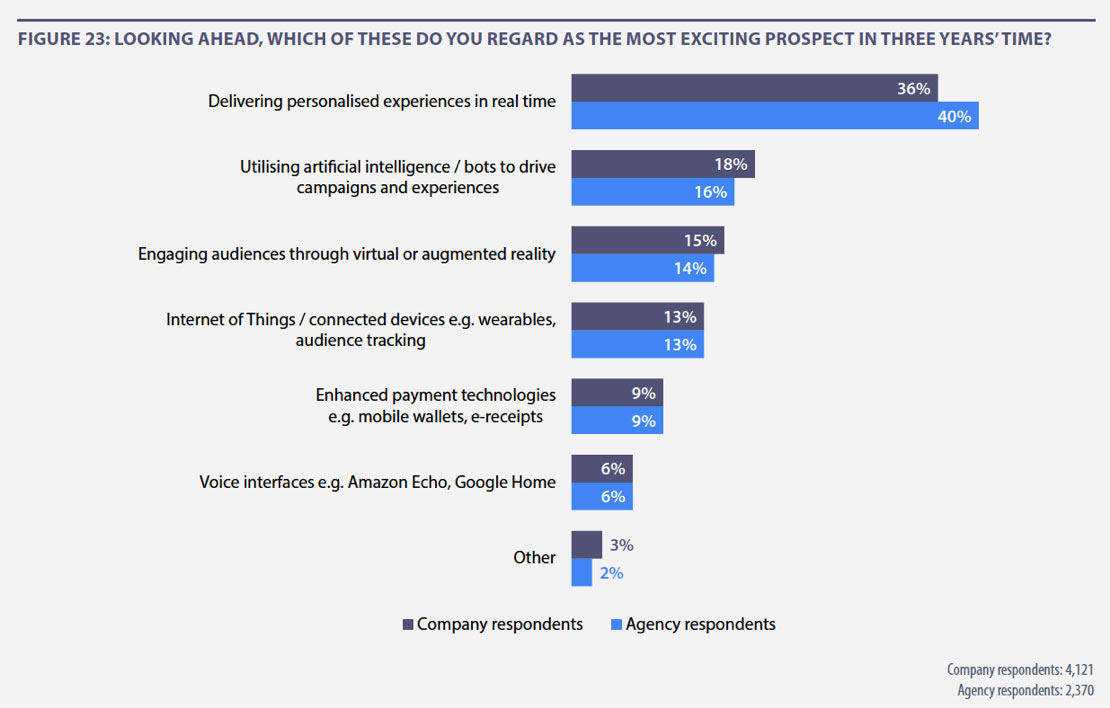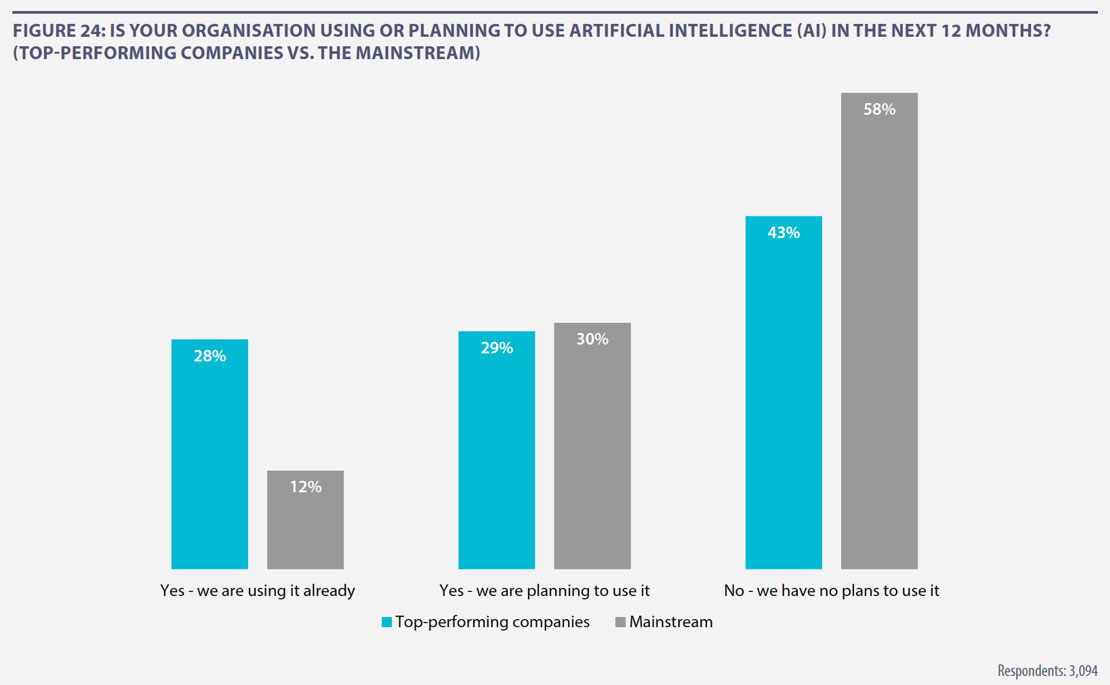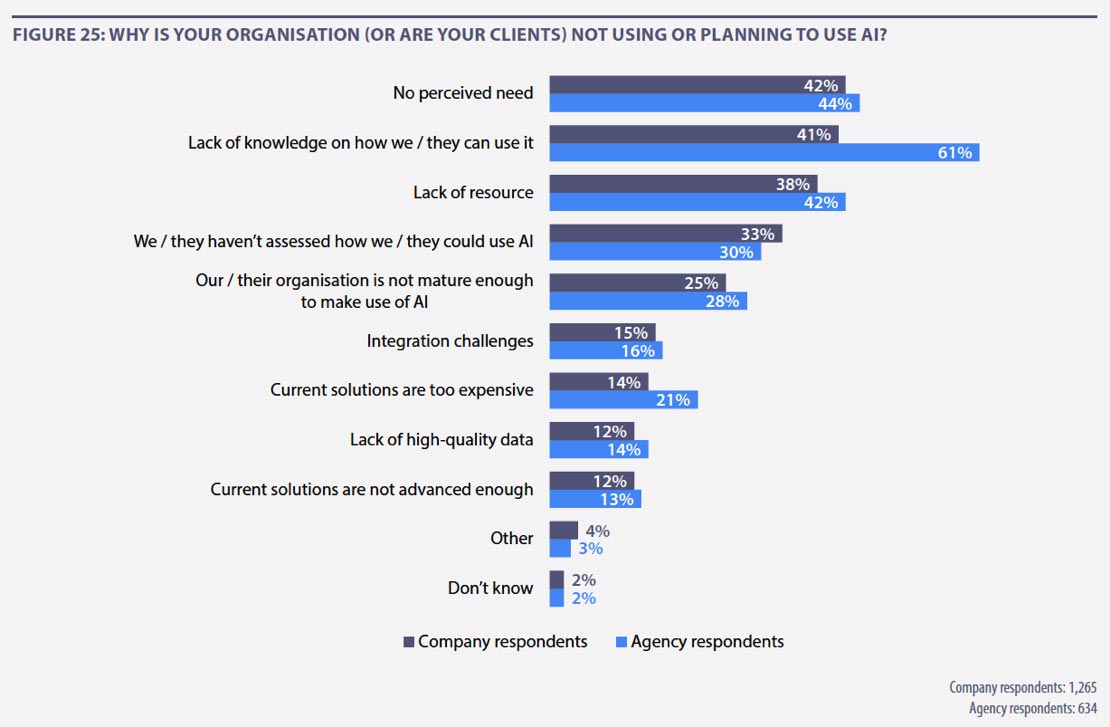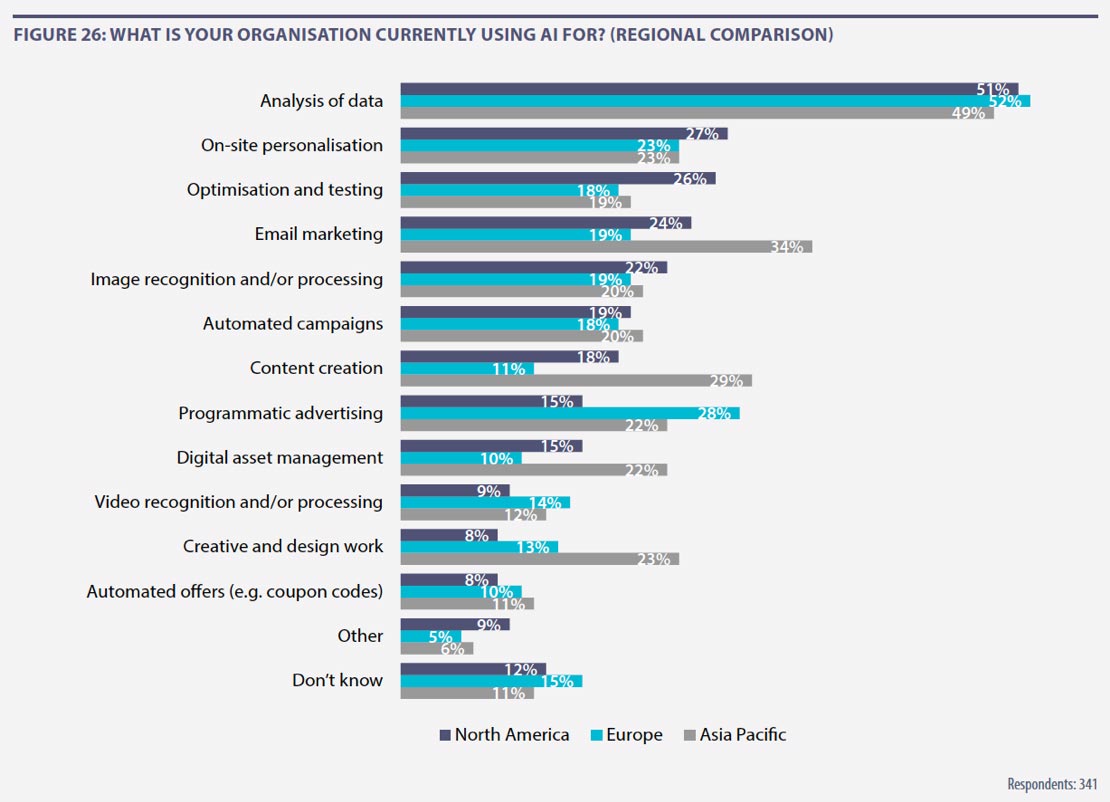Looking ahead – AI set to help companies with quest to provide more compelling real-time experiences
In an industry where innovation is constantly creating fresh opportunities to engage users, it remains crucial for marketers to keep gazing into the crystal ball, and to monitor the technology pipeline. Everyone has finite resources, however, and judging where to focus investment is key to success.
We asked marketers to highlight some of the themes and technologies they are most excited about over a three-year timeframe (Figure 23). ‘Delivering personalised experiences in real time’ is by far the most popular choice across all regions, with more than a third (36%) of company respondents, and 40% of their agency counterparts, selecting this option.
The responses suggest that while plenty of interesting technologies are emerging, marketers are avoiding the distraction. Instead, they remain focused on delivering against core objectives, namely creating a relevant, timely and engaging experience for each of their users, to maximise sales and efficiency. Many marketers, for example, remain focused on personalisation of their communications with users, a trend that cuts across numerous digital marketing techniques, including analytics, marketing automation, programmatic ad buying and dynamic content. This is ‘unfinished business’, though, and there is plenty of room to hone these capabilities further.

The report finds that organisations that ‘have the tools to use data in order to create compelling, personalised, real-time experiences’ are 50% more likely than their peers to have exceeded their 2017 business goals by a significant margin (21% vs. 14%). There are ample gains to be had if businesses can elevate themselves above the noise of more traditional, one-size-fits-all marketing.
At the same time, true one-to-one marketing is not something that has been widely cracked, by any means, and marketers clearly see potential to drive gains much further.
More ‘bleeding-edge’ trends, such as virtual reality, are on marketers’ radar, but there is greater focus on real-time personalisation’s potential for deeper connection with users, progressively learning more about them, and serving them with the right content and messaging at key moments and touchpoints.
Perhaps surprisingly, given recent levels of attention, ‘excitement’ about voice interfaces such as Amazon Echo and Google Home is only in single figures. Although these present a new way for users to navigate the digital world – and research companies’ products and services – it appears that many brands are yet to be convinced of the case for tapping into them, even though new research from Adobe Digital Insights (ADI) found that voice-assistant sales had grown 103% year on year in the fourth quarter of 201715.
AI Still to Inspire
AI is one area of digital that has generated a copious amount of media coverage, and our analysis shows that this level of interest is justified. As Figure 24 shows, top-performing companies are more than twice as likely to be using AI for marketing (28% vs. 12%), with this technology increasingly helping companies in their quest to provide more compelling real-time experiences.
AI is already helping marketers in many different ways, including creation of content at scale in a way which is not feasible without the aid of machine learning16. Companies are also increasingly able to communicate with customers and prospects on a one-to-one basis using AI-powered chatbots, and to make smarter recommendations based on the analysis of a myriad of data sources.
As well as making laborious processes infinitely faster, technologies such as Adobe Sensei can draw on huge volumes of content and data to help marketers understand hidden opportunities by surfacing insights previously beyond their reach. As well as helping marketing, Adobe Sensei is able to serve designers with abilities such as image identification and matching, face recognition and timesaving ‘design-intelligence’ features.

Although only 15% of respondents say their companies are currently pushing forward with AI use cases, that percentage increases to 24% for organisations with annual revenues of more than £150m. Additionally, the C-suite and top management are nearly 50% more likely to say that their companies are already using or planning to use AI than junior executives (57% vs. 39%). The greater the seniority, the more likely they are to have visibility into the strategic plans of the organisation and push investment in AI further up the agenda.
Despite the obvious advantages of AI for marketers, there is certainly more room for uptake of this technology. Less than one in five (18%) respondents describe ‘utilising AI / bots to drive campaigns and experiences’ as their most exciting prospect for three years’ time (Figure 23). Furthermore, a majority of respondents have no plans to use AI over the coming year.
The slow adoption could be put down to confusion or lack of knowledge around AI’s applications, amid widespread concerns over the societal impact of automation in general. AI and machine learning should be seen as an ‘enabler’ for marketing professionals to perform tasks more efficiently and effectively, whether in delivering customer experience (via chatbots), generating content, enhancing website design, aiding programmatic ad buying, or in numerous other use cases that have been put forward for AI-equipped marketing.
Demand-side factors are the main barrier to adoption of AI at this point, rather than the expense or readiness of current solutions.
Many respondents have concerns over the challenges of assimilating AI into their existing ways of working. Across all regions, more than a third of marketers report they have a lack of knowledge (41%) on how they can use AI or a lack of resource (38%) to address it (Figure 25). A quarter (25%) of respondents, again across all regions, indicate their organisation is not mature enough to make use of AI.

On a regional basis, Asia Pacific marketers are more open and enthusiastic towards AI than their European and North American peers. Within the APAC marketer base, 38% see ‘no perceived need’ for AI, compared with 51% of marketers in North America, although this remains a strikingly large base of users that AI proponents need to win round.
A majority (53%) of APAC marketers are either using AI already, or are planning to use it in the next 12 months, whereas in Europe and North America, adopters are in the minority.
As would be expected, with their greater access to new systems and services, agencies are well ahead of in-house respondents when it comes to reporting AI adoption.
It is also notable that different regions are coming at AI from slightly different angles (Figure 26). Analysis of data is a key focus for all geographies, a mark of the ongoing struggle to create insight out of the vast quantities of often unstructured data being generated by customers’ activity.
In North America, marketers are more interested than their peers in using AI to enhance ‘core’ digital marketing techniques such as optimisation and testing, and on-site personalisation. This could reflect North American marketers’ greater focus on optimisation of the customer journey, discussed previously in this report.
In Asia Pacific, these areas are also of interest, but numerous, narrow use cases are also being targeted, such as use of AI in content creation, creative and design work, and digital asset management. In the design sphere, AI provides an opportunity to build on capabilities such as dynamic creative optimisation, which helps test the impact of different ad elements, whether images or copy, on different audience segments17. M&C Saatchi, Clear Channel and Posterscope, for example, purported to have deployed an ‘artificially intelligent’ poster campaign back in 2015, dynamically serving different ads to users, based on responses tracked through a camera.
